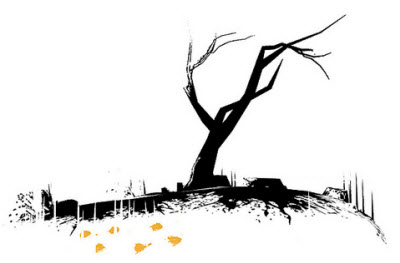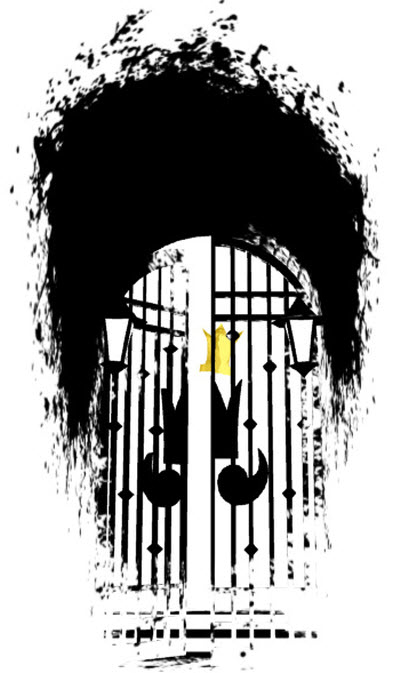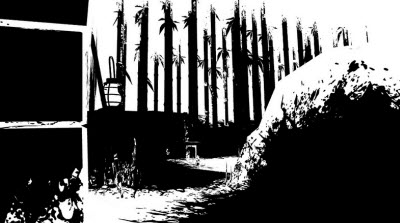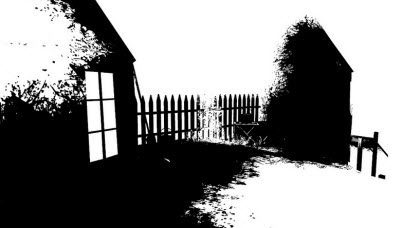Warning: This review may contain spoilers, but we’ve tried to minimize that.
The Unfinished Swan is an interactive fairy tale that begins like no other game. As soon as it sets up the backstory, you face a white screen. You can turn around, and that is all you see. If you press the right trigger, you lob a blob of black paint. As it lands with a “plop,” you see that the black paint uncovers part of the 3D space hidden within the white. That is the first of many magical moments within this PlayStation Network downloadable game for the PlayStation 3.
 It is a game about exploring the unknown. But that exploration is tied closely to your progress in unfolding a fairy tale-like story about a little boy and his pursuit of meaning under sorrowful circumstances. For much of The Unfinished Swan, the developer Giant Sparrow masterfully interleaves the exploration and the storyline. But by the end, the developer loses control, introduces ambiguity and doubt, and leaves the player feeling unfulfilled and empty. I still don’t know if it was intentional or not, but the game’s story feels unfinished.
It is a game about exploring the unknown. But that exploration is tied closely to your progress in unfolding a fairy tale-like story about a little boy and his pursuit of meaning under sorrowful circumstances. For much of The Unfinished Swan, the developer Giant Sparrow masterfully interleaves the exploration and the storyline. But by the end, the developer loses control, introduces ambiguity and doubt, and leaves the player feeling unfulfilled and empty. I still don’t know if it was intentional or not, but the game’s story feels unfinished.
Despite those concerns, Unfinished Swan is a wonderful first effort by Giant Sparrow, a new Santa Monica, Calif., game studio headed by Ian Dallas. He started it as a student project in the University of Southern California’s Interactive Media program. But the finished game is by no means an amateur effort, and everybody should play it to see for themselves whether it ultimately makes sense or not.
Dallas wrote the story about an orphan boy named Monroe. At the beginning, a narrated sequence tells us that Monroe’s mother was an artist who created more than 300 paintings — but never finished them. She died and Monroe was sent to an orphanage, which only allowed him to keep one of the paintings. He chose a portrait of an Unfinished Swan. But one day, the swan walked out of the picture, and Monroe began a quest to find it. As Monroe, you follow the swan through the landscape. You toss paint and uncover a whole 3D landscape, always following the orange footprints of the swan (as pictured above). You always feel like the swan is leading you, but you can stop along the way and make delightful discoveries. And ultimately, you learn more about yourself and a mysterious King (played by Terry Gilliam), who is the crazy artist who constructs all of the magical art work in the game.
 We can all identify with the inability to finish something. Dallas has described a child as a kind of unfinished work of art, and that view is worth remembering as you come upon all of the unfinished works in the game. As Dallas said in an interview with me, “The feeling you get is thinking about unfinished spaces in life,” Dallas said. “What kind of world would be white? Maybe the kingdom you are exploring is an unfinished kingdom. To me, the most unfinished thing is to create a child and to leave before they’re done, before they grow up.”
We can all identify with the inability to finish something. Dallas has described a child as a kind of unfinished work of art, and that view is worth remembering as you come upon all of the unfinished works in the game. As Dallas said in an interview with me, “The feeling you get is thinking about unfinished spaces in life,” Dallas said. “What kind of world would be white? Maybe the kingdom you are exploring is an unfinished kingdom. To me, the most unfinished thing is to create a child and to leave before they’re done, before they grow up.”
WHAT YOU’LL LIKE
Wonderful creativity
The game has a fairy-tale charm to it, and its zany series of episodes that are like something out of Lewis Carroll’s Alice in Wonderland. It is a little like Thatgamecompany’s Journey, with little or no violence, unless you count getting attacked by an insect-like creature in the dark. It also borrows a tough puzzle from Valve’s Portal game, which has physics problems that will make your head spin. But the blending of these different influences is subtle, making Unfinished Swan wholly original.
It holds great appeal to both young and old alike, and I enjoyed playing it with one of my children. But its story has mature elements (which I discuss below) that make it less appropriate for young children. You feel not like a player, but as an artist. You are part of the story, and you are using your paint (and later, other tools) to give the world its structure. Monroe is an active participant.
Mapping out a new world
This world is simply animated. You find austere gardens and ponds. They are functional, with no more detail than they need to reveal so that you can get on with your journey.
Unfinished Swan has four chapters, each of them taking about an hour to play. And each of them is very different. The black-and-white world reveals itself to you one step at a time. You get a small understanding of what it might like be like to be a blind person, where spaces reveal themselves to you bit by bit. But with each new chapter, the world changes. You get the sense for what it’s like to scale the walls of a big city, find your way through a labyrinth, and explore other unfamiliar places. In each case, you get a sense for what it’s like to not know where you are going and to only discover your destination at some point in the middle of the journey. While each of the spaces is different, they all leave you with this weird kind of feeling of being rudderless.
But just as you feel when you don’t know where to go next, it leads you somewhere. It drops a hint (like the crown in the above picture) for you to pursue. And the swan itself constantly shows up. Just as you’re about to catch it, the swan flies away and moves on, stringing you along to where you have to go next. This solution is a wonderful way to combine the exploration and narrative story.
Fairy tale-like narrative
Unfinished Swan tells its story in pieces. If you finish a section of exploration, you can see an orange letter in the landscape. When you hit that letter with a blob, the whiteness melts away to reveal a written storybook passage, which a narrator (played by Dallas’ aunt) reads out loud. The story is intriguing and draws you into the tale of the King, an artist who creates a dream-like world that drives away his own subjects.
At some point, Unfinished Swan introduces you to the figure of the Queen. She leads Monroe to start discovering more things about himself and his place in the world. As the tale progressed, I became more interested in who the Queen was and who the King was. You find out just how child-like the King is, like in a scene when you learn he hates the sea because it once washed away his sand castle. You start to feel like this fairy tale is meant for Monroe, and that he is going to learn something from it. The story has an arc, and the chapter divisions make sense. You go on a journey in this game, and the mood changes in each chapter.
Giant Sparrow came up with a wonderful new game mechanic of tossing paint at a white space, which is akin to uncovering the fog of war in a strategy game. As novel as this is, it gets old. You get tired of looking at a world in black and white. The developers work this feeling into the story, and then Unfinished Swan changes. Just when you think it has gotten predictable, you must find a new way of solving puzzles and making progress. One surprise: If you walk far enough, Monroe will pick up his pace and start to run. That’s a secret.
Humor
The game has a sense of humor. The King likes to make pottery, but he refuses to provide a sewer system for his subjects. When they start relieving themselves in the pots, the King relents.
Mind-bending puzzles
The King may not be very sociable, but he has a knack for building interesting puzzles that present a lot of challenges. At one point, you enter an area where it’s easy to get lost. But if you noticed a painting on the wall in an earlier scene, you would know the way to get through that area of the game.
In one scene, you discover that you are in an endless loop. It feels like you’ve walked into M.C. Escher’s Relativity painting. You eventually learn that you have to do something to get out of the loop. The Valve-like puzzle turns out to be an easy one to solve if you’ve played Portal before. But if you haven’t. it could be hard. I generally found that the tougher puzzles extended the game by minutes. But they weren’t so tough that they extended the game by hours. That’s what I like. It’s challenging, but not impossibly so.
One of the challenges is to find all of the balloons in every scene. They aren’t easy to find, so you may go back over ground you’ve traveled before in order to find them. That’s a simple trick that encourages replaying. You can also try to navigate your way through the all-white scene without using much paint. If you do it with three or less blobs of paint, you get a trophy.
Great music
The music is great throughout the journey, and it actually reminded me of the wonderful music in Thatgamecompany’s Journey. Dallas consciously worked with Peter Scaturro, the music supervisor at the Sony Santa Monica Studio, to create a score that offset the melancholy of the story. Dallas said he consciously steered away from anything that felt too sad, stark, or desolate. Instead, the music is lush, warm, and curious, he said. That’s because the music is really your only companion as you work your way through the game. You hear a lot of harp music during the narrative scenes and marimba as well. The music is ambient, always changing as you go from place to place.
Theme too mature for young kids
The game is rated E10+, meaning that everyone 10 years old and older can play. But it’s too bad that the developer chose to include mature themes in the story. You won’t want to play the game with your youngest children, unless they’re made of stout stuff and don’t mind discussions about death and losing your parents. It is good that Giant Sparrow included the narrative fragment about a mother who died at the beginning, to warn parents that the story might not be great for young ones.
But the problem is that Unfinished Swan is such a novelty with its paint-tossing game play that everyone will be attracted to it. It has scenes where you’re in the dark and you’re being attacked by something. That scene comes as an unwelcome surprise for those who are expecting only wonderful discoveries in the game.
And finally, the ending of the story turns to the subject of death and disturbing dreams. We’ll touch on that below. I’m pointing this out so that it doesn’t catch parents unprepared. You can say it’s about self-discovery and exploration, but that’s pointing to the light and ignoring the darkness.
Having said that, Unfinished Swan is far more attractive to parents who are sick and tired of violent games. It has no harsh language or anything really offensive in the game.
A lonely trek with not enough characters
Monroe’s journey is a solitary one. Nowhere does he run into any cool characters and have a conversation with them. In that respect, we don’t get to know Monroe well at all. While the world is as creative and zany as Alice in Wonderland, it is not the kind of fairy tale where you get the joy of discovering new people or characters and having conversations with them. It is one reason why, despite the magical environment of the game, you can wander through it feeling sad and empty. When you start tossing paint around and see cool things like whale-like sea monsters, you wish that you could go up to them and have a conversation with them. But the only person who can talk to is the King. If you’re expecting to have a heart-to-heart with the swan, well, don’t count on it.
You see a pet hippo on a couple of occasions, but you don’t get a chance to interact with it. The loneliness takes you back to the notion that this is a story about a boy who has lost his mother. Emptiness and wonder may go together, but happy chatter might very well be out of place in this game. That’s too bad, because it really does have a chance to be as good and funny as Alice in Wonderland.
An unclear ending (some spoilers)
Toward the end, the pace picks up. The narrator starts talking faster, describing the King’s experiences to Monroe. If you don’t pay close attention, you may miss something important. During this ending, the storybook narrator tells you things that maybe would be better acted out in the game. The tale is very whimsical, and so you might expect a nonsensical ending. Furthermore, it’s a dream, and so you don’t need a satisfying ending to a dream. The Queen’s abrupt departure from the story is troubling, and it reminds you that this tale starts with a death. It leads the King to start thinking about his own death and how to leave a legacy for the ages. All of that is fine for the creators to relate as their ending.
But the thing I didn’t like is that I didn’t understand the ending. I’m itching to have conversations about what it means. But it has just a lot of ambiguity. Are you going to pick up where the King left off and become the next mad artist? Who really was whom in the story? For sure, great art leaves you with more questions than answers. But Unfinished Swan seems to delight in leaving me puzzled. My question is, “What did I just play?”
I finished the game in a few hours. (It might have been about four). And I’m running through it again. But this is one of those experiences that is almost more like watching a movie. You can play it all in one evening, and it will leave you wanting more.
CONCLUSION
You could argue that the unsatisfying ending leaves some room for a sequel or downloadable content (DLC). But gamers are not necessarily a forgiving lot. If you ask them to spend hours playing a game, and then deny them an interesting ending, the result may not be good. Just as the folks at BioWare who created the ending for Mass Effect 3. This ending isn’t as bad as that one, but it is ambiguous.
This game started out with two people and grew to 12. And all of them get some extra-generous credits at the end. But it is astounding to me that such a small team can create a game that is as moving and inspiring as The Unfinished Swan. It is the kind of game that big game studios won’t make, to their loss.
Score: 88/100
The Unfinished Swan will be available for PlayStation Plus members on Oct. 16 in the U.S. and Oct. 17 in Europe. For nonmembers, it will be available on Oct. 23 in the U.S. It will cost $14.99 in the U.S. and 12.99 euros in Europe. The publisher provided GamesBeat with a code for the game for the purpose of this review.
VentureBeat's mission is to be a digital town square for technical decision-makers to gain knowledge about transformative enterprise technology and transact. Learn More




